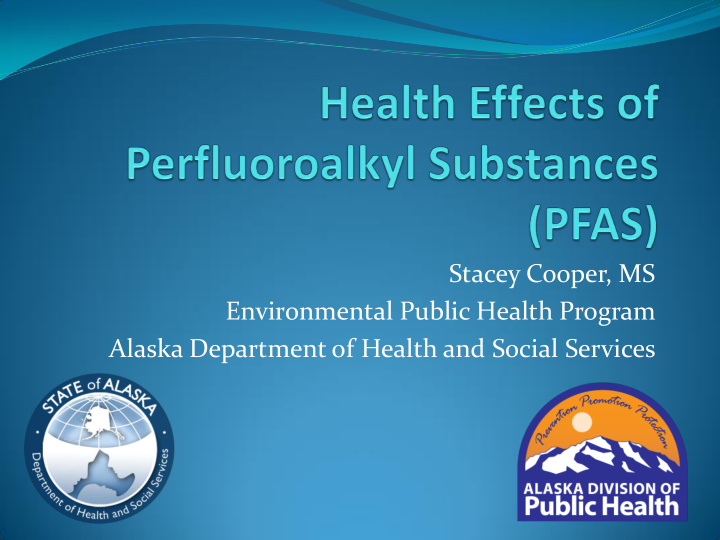



Stacey Cooper, MS Environmental Public Health Program Alaska Department of Health and Social Services
What are PFAS? Human-made chemicals used for decades for both residential and industrial purposes. Used in fire fighting foams as well as products that are stain, grease, or water resistant (e.g., fast food containers, carpets, upholstery). They do not break down in the environment and can travel long distances in air and water.
How Can I Be Exposed to PFAS? Drinking contaminated water Ingestion of contaminated food Incidental ingestion from hand-to-mouth transfer from surfaces treated with protectants or dust containing PFAS
PFAS in Drinking Water EPA lifetime health advisory recommends that the concentration of PFOA and PFOS in drinking water, individually or combined, not exceed 70 nanograms per liter (ng/L) or parts per trillion (ppt). EPA health advisories are non-regulatory but provide https://www.epa.gov/ground-water-and- drinking-water/drinking-water-health- recommendations. advisories-pfoa-and-pfos
Health Effects of PFAS PFAS are an “emerging” contaminant which means that risk to human health and the environment may not be known. Studies have focused mainly on two PFAS: PFOS and PFOA . PFOS is the major PFAS found in some of the wells near the FAI.
Health Effects of PFAS In a U.S. national study (NHANES) nearly everyone had some level of PFAS in their blood (2,094 participants). If you have PFAS in your blood, it does not mean you will suffer adverse health effects Body’s natural elimination processes are the only way to remove PFAS from the body.
PFAS Half-life in Humans Substance Estimated Half-life Perfluorooctanoic acid (PFOA) 2-4 years Perfluorooctanesulfonic acid 5-6 years (PFOS) Perfluorohexane sulfonic acid 8-9 years (PFHxS) Perfluorobutane sulfonic acid 0.1 years (PFBS) https://www.atsdr.cdc.gov/pfc/docs/pfas_clinician_fact_sheet_508.pdf
Blood Levels of the Most Common PFAS in People of US (2000-2014) *Data shown are geometric mean. Note: A s PFOS and PFOA are phased out and replaced, people may be exposed to other PFAS. Data Source: Centers for Disease Control and Prevention. Fourth Report on Human Exposure to Environmental Chemicals, Updated Tables, (January 2017). Atlanta, GA: U.S. Department of Health and Human Services, Centers for Disease Control and Prevention.
Comparison of PFAS Levels in Blood PFOS
Comparison of PFAS Levels in Blood PFOA
Health Effects of PFAS Some studies suggest that exposure to PFAS above certain levels could be linked to: Developmental effects in fetuses and offspring Lower birth weight Delayed development Liver tissue damage Immune effects (antibody suppression and immunity) Thyroid effects (T4 and TSH levels) High cholesterol
PFAS and Cancer Risk Some studies have linked exposures to PFOA with kidney and testicular cancer, but others have shown no cancer risk. World Health Organization’s International Agency for Research on Cancer has found that PFOA is possibly carcinogenic to humans. EPA classified PFOA and PFOS as possibly carcinogenic to humans. PFOA
Bathing and skin absorption Skin does not absorb enough PFAS to make bathing and showering a problem. PFAS do not irritate the skin or eyes in the levels found in your well water. PFAS do not move easily from water to air, so it is unlikely you will breath them in.
Recommendations Drink water from an alternative source if PFAS in your well water are at or above EPA’s Lifetime Health Advisory (LHA) – 70 nanograms per liter of water. This goes for pets and livestock as well If your water is above the health advisory, using alternate water to brush your teeth will reduce your exposure to PFAS. It’s OK to shower and bathe with your water. It’s OK to clean your house and clothes with well water.
Recommendations - Gardening If your water is below the health advisory level of 70 nanograms/liter PFAS, then it’s OK to use in your garden. Information we have for water with PFAS levels over the health advisory levels is unclear. Some vegetables like lettuce and other leafy vegetables absorb more PFAS than root vegetables like potatoes and carrots. Peeling potatoes and carrots will help lower any PFAS contamination in those vegetables.
Recommendations OK to breastfeed. Benefits of breastfeeding outweigh the potential risks. If PFAS levels in your well are above the health advisory level, we recommend using alternate drinking water if you are a breastfeeding mother.
Questions? Stacey Cooper, MS Health Assessor Environmental Public Health Program (907) 269-8016 stacey.cooper@alaska.gov Joe Sarcone, MSPH Environmental Health Scientist ATSDR Region 10 (907) 271-4073 iqq5@cdc.gov CDR Arthur Wendel, MD, MPH Regional Representative, ATSDR Region 10 (206) 553-0454 wendel.arthur@epa.gov
Recommend
More recommend